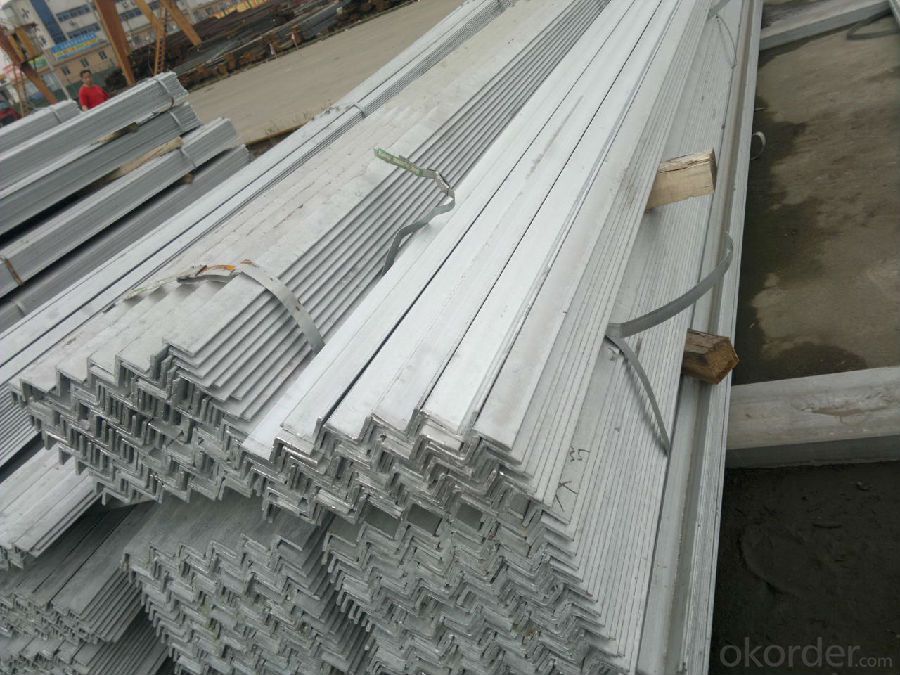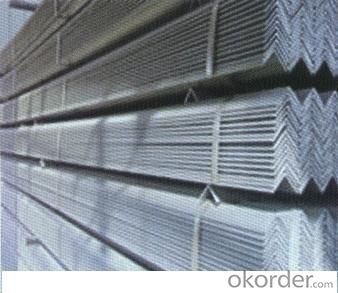A60*60*6 galvanized angle steel for construction
- Loading Port:
- Tianjin
- Payment Terms:
- TT OR LC
- Min Order Qty:
- 25 m.t.
- Supply Capability:
- 10000 m.t./month
OKorder Service Pledge
OKorder Financial Service
You Might Also Like
Product Description:
Packaging & Delivery
| Packaging Detail: | Containers Or With Other Clients' Requirements. |
| Delivery Detail: | within 15 days |
Specifications
angle steel
1. Standard: AISI,ASTM,BS,DIN,GB,JIS
2. Dimension: 10*10mm-200*200mm
3. Length: 3m - 12m
s235jrg hot dip galvanized equal unequal steel angle angle steel
| Standard | AISI,ASTM,BS,DIN,GB,JIS |
| Dimension | 10*10mm - 200*200mm |
| Grade | Q195-Q420 Series |
| Place of origin | Tianjin China (Mainland) |
| Brand Name | DC METAL |
| Model Number | 2#-20# |
| Type | Equal |
| Application | construction |
| Length | 3-12m |
1.MOQ:20 Ton
2.Material:Q195,Q235
3.Size:0.7--3mm
4.Used for:upvc door and window
| Name | steel lining,steel angles,steel framing ,metal frames, The doors and windows strengthen steel |
| Technique | Cool rolled |
| Thickness | 0.7~~3.0mm |
| Dimensions | 12mm*150mm*1.5mm(Size range Or Other Size According To The Contract) |
| Length | 5.8m usually Or Other Size According To The Contract. |
| Steel Material | Q195-Q235 |
| Type | C,L,U,or Profiled steel angle. |
| Application | The doors and windows strengthen steel. |
| Surface | Bared Or Painted, Galvanized Or Clients’ Option. |
| Country of Origin | China(mainland) |
| Package | Containers Or With Other Clients' Requirements. |
| Port | Tianjin |
| Delivery Time | Within 15 days(30% in advance) |
Sdandards: | ASTMA53,ASTMA106,BS1139,BS1387-1985,GB/T3091-2001,EN39
| |||||
Material: | Q195,Q235,Q345,A53,A36,SS400,SS330,ST37-2,08YU,
| |||||
Technical: | welded:longitudinal welded,SSAW
| |||||
Application | Construction structure,furniture,shipbuilding,petroleum, | |||||
Power,gas metallurgy | ||||||
Package | Hex bundle by steel strip | |||||
In bulk | ||||||
anti-water plastic woven | ||||||
As your requirement | ||||||
Place of origin | Tianjin China | |||||
transaction conditition | Trade terms: EXW,FOB,CIF,C&F | |||||
Delivery time: 10-20days after receiving your deposits | ||||||
Payment term: 30% by TT in advance | ||||||
Load port: Tianjin Xingang Port | ||||||



- Q:What are the tolerances for steel angles?
- The tolerances for steel angles may differ based on the particular grade and manufacturing standards. Nevertheless, typical tolerances for steel angles commonly encompass dimensional tolerances like length, width, and thickness. These tolerances guarantee that the steel angles meet the necessary specifications and can be effectively employed in diverse applications. Concerning length, the tolerance usually spans from ±1/8" to ±1/4", contingent upon the angle's size and grade. This signifies that the actual length of the angle can fluctuate within this range from the specified length. Likewise, for width, the tolerance can vary from ±1/8" to ±1/4", ensuring that the actual width of the angle falls within this range from the specified width. Regarding thickness, the tolerance can differ depending on the manufacturing process and the grade of the steel angle. However, customary tolerances for thickness may range from ±1/16" to ±1/8". This tolerance guarantees that the actual thickness of the angle is within this range from the specified thickness. It is crucial to note that these tolerances serve as general guidelines and may vary based on the specific requirements and standards established by manufacturers or industry regulations. Therefore, it is always advisable to refer to the product specifications or consult the manufacturer for accurate and up-to-date information on tolerances for steel angles.
- Q:Are there any limitations on the angle of inclination for steel angles?
- Yes, there are limitations on the angle of inclination for steel angles. The angle of inclination refers to the angle at which the steel angle is installed or positioned in a structure. The limitations on this angle depend on various factors, including the type and thickness of the steel angle, the load it is expected to bear, and the specific design and engineering requirements of the structure. In general, steel angles can be installed at various angles of inclination, ranging from vertical (90 degrees) to horizontal (0 degrees). However, there are practical limitations that need to be considered. Steel angles are typically designed to bear loads in a specific direction, and deviating too far from the intended angle of inclination can impact their structural integrity and load-bearing capacity. Furthermore, the installation angle of steel angles may be limited by the connection methods used. Welding, bolting, or other fastening techniques may have specific requirements for the angle of inclination to ensure proper connection strength and stability. It is important to consult the relevant building codes, standards, and engineering guidelines to determine the specific limitations on the angle of inclination for steel angles in a particular application. Professional structural engineers can provide the necessary expertise and guidance to ensure that the steel angles are installed within safe and appropriate limits.
- Q:What does angle 5 mean?
- Angle called angle, the steel strip is perpendicular to each other on both sides into the corner. There are equal angles and unequal angles. The two sides of an equal angle steel are equal in width.
- Q:Are steel angles resistant to chemicals?
- Yes, steel angles are generally resistant to chemicals due to their high durability and corrosion resistance. However, their resistance may vary depending on the specific type of chemical and environment they are exposed to.
- Q:Are steel angles resistant to high winds?
- Yes, steel angles are generally resistant to high winds due to their robust structure and strength. They are commonly used in construction and engineering projects to provide stability and support against strong winds.
- Q:How do you prevent steel angles from rusting?
- There are multiple techniques for preventing the rusting of steel angles: 1. Utilizing Protective Coatings: Applying protective coatings on the surface of steel angles proves to be an effective method in preventing rust formation. Common options for coatings include paint, epoxy, enamel, and galvanized coatings. These coatings serve as a barrier, obstructing the access of moisture and oxygen to the steel surface, thus minimizing the likelihood of rusting. 2. Implementing Rust Inhibitors: Rust inhibitors, which are chemical compounds, can be employed on steel angles to prevent rust formation. These inhibitors work by either creating a protective layer on the steel surface or actively hindering the corrosion process. Rust inhibitors can be administered as sprays, coatings, or even incorporated during the manufacturing process of the steel. 3. Ensuring Proper Storage and Handling: An uncomplicated approach to prevent rust is by appropriately storing and handling steel angles. This entails keeping them in a dry environment, preferably indoors or under some form of protective covering, to avoid exposure to moisture and humidity. Additionally, handling steel angles with clean, dry gloves can prevent the transfer of moisture from hands, which accelerates the rusting process. 4. Regular Maintenance: Regular inspection and maintenance of steel angles aid in identifying and remedying any indications of rust formation at an early stage. Timely removal of any rust spots using wire brushes or sandpaper, followed by the application of touch-up coatings, can deter further corrosion. 5. Dry Storage and Adequate Ventilation: When storing steel angles outdoors, it is crucial to ensure they are placed in a well-ventilated area to promote air circulation and prevent the accumulation of moisture. Additionally, covering the angles with a waterproof tarp or plastic wrap provides an additional layer of protection against rain, snow, and other weather elements. By employing a combination of these preventive measures, steel angles can be safeguarded against rust formation, ensuring their durability and structural integrity.
- Q:Can steel angles be used as lintels or beams in construction?
- Yes, steel angles can be used as lintels or beams in construction. Steel angles are versatile structural elements that can provide support and strength to various types of structures. They are commonly used in construction projects for their ability to bear heavy loads and resist bending or warping. When used as lintels, steel angles are typically installed horizontally above doors and windows to distribute the weight of the structure above and prevent the opening from sagging. As beams, steel angles can be used to support floors, roofs, or other structural components. They are often preferred for their durability, versatility, and cost-effectiveness compared to other materials. However, it is important to consult with a structural engineer or construction professional to ensure that the specific steel angles being used are suitable for the intended application and meet the required building codes and standards.
- Q:Can steel angles be used as structural members?
- Yes, steel angles can be used as structural members. Steel angles are commonly used in construction and engineering projects to provide structural support and stability. They are often used to reinforce and strengthen various structures, such as buildings, bridges, and frameworks. Steel angles are known for their high strength and durability, making them an ideal choice for structural applications. They can be used in combination with other steel components or on their own to bear or distribute loads, support beams, and provide stability to the overall structure. Additionally, steel angles can be easily fabricated and installed, making them a versatile and cost-effective option for structural members in various construction projects.
- Q:Are there any industry standards or certifications for steel angles?
- Yes, there are industry standards and certifications for steel angles. The most widely recognized standard for steel angles is the American Society for Testing and Materials (ASTM) standard. The ASTM A36 specification is commonly used for structural steel angles and provides specific requirements for chemical composition, mechanical properties, and dimensional tolerances. In addition to ASTM, other organizations such as the American Institute of Steel Construction (AISC) and the Steel Joist Institute (SJI) provide guidelines and standards for steel angles used in construction and structural engineering applications. These standards ensure that steel angles meet specific requirements for quality, strength, and performance. Furthermore, certifications such as ISO 9001:2015 and ISO 14001:2015 are widely recognized in the steel industry, indicating that a manufacturer has implemented a quality management system and meets environmental management standards. It is important for manufacturers, suppliers, and construction professionals to adhere to these industry standards and certifications to ensure the reliability and safety of steel angles in various applications.
- Q:How do you cut steel angles to size?
- To cut steel angles to size, you can use various tools such as a hacksaw, angle grinder, or a band saw. Measure and mark the desired length on the steel angle, then secure it in a vise or clamp it down. Use the chosen cutting tool to carefully cut along the marked line, ensuring steady and controlled movements. It is important to wear appropriate safety gear, such as goggles and gloves, and to follow proper cutting techniques to ensure a clean and accurate cut.
1. Manufacturer Overview |
|
|---|---|
| Location | |
| Year Established | |
| Annual Output Value | |
| Main Markets | |
| Company Certifications | |
2. Manufacturer Certificates |
|
|---|---|
| a) Certification Name | |
| Range | |
| Reference | |
| Validity Period | |
3. Manufacturer Capability |
|
|---|---|
| a)Trade Capacity | |
| Nearest Port | |
| Export Percentage | |
| No.of Employees in Trade Department | |
| Language Spoken: | |
| b)Factory Information | |
| Factory Size: | |
| No. of Production Lines | |
| Contract Manufacturing | |
| Product Price Range | |
Send your message to us
A60*60*6 galvanized angle steel for construction
- Loading Port:
- Tianjin
- Payment Terms:
- TT OR LC
- Min Order Qty:
- 25 m.t.
- Supply Capability:
- 10000 m.t./month
OKorder Service Pledge
OKorder Financial Service
Similar products
New products
Hot products
Related keywords



























